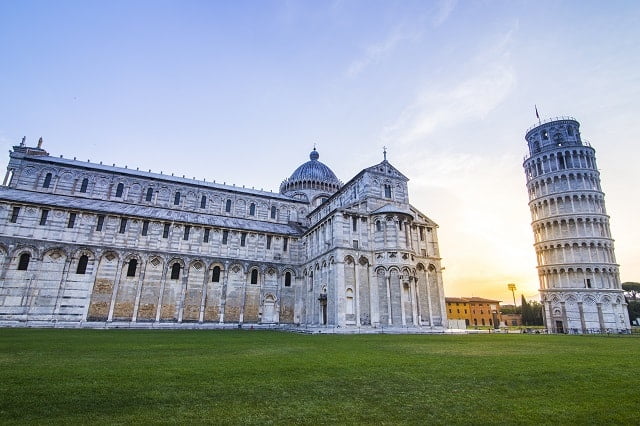Italy holds a special allure for travelers around the world, with its rich history, stunning art and architecture, delectable cuisine, and vibrant culture. From the romantic canals of Venice to the ancient ruins of Rome, Italy offers a diverse range of attractions and experiences that cater to every type of traveler. With its iconic cities, charming villages, and breathtaking landscapes, Italy has something for everyone.
One essential aspect of experiencing Italy to its fullest is engaging with the Italian language. Learning basic Italian phrases can open doors to deeper connections with locals and enhance your travel experience. Additionally, immersing in Italian culture means indulging in the renowned culinary delights that are synonymous with this country. Each region boasts unique dishes and flavors that showcase the diversity of Italian cuisine.
The art and architecture found throughout Italy are also integral to its cultural identity. The country is home to some of the world’s most famous masterpieces, from the Sistine Chapel’s ceiling in Vatican City to Florence’s Renaissance treasures.
Exploring beyond the popular tourist spots can lead travelers to hidden gems that offer a more authentic glimpse into Italian life and traditions. As we delve into this article about Italian travel, we will explore these aspects in greater detail while providing practical tips for navigating this enchanting destination.
The Italian Language
The Italian language is not only a means of communication, but it also serves as a gateway to truly immersing oneself in the culture and lifestyle of Italy. As one of the romance languages, Italian has a musical and melodic quality that captivates the ears of those who hear it. Learning even basic Italian phrases can enhance the travel experience by fostering connections with locals and allowing for a deeper understanding of Italian culture.
Importance of Language in Experiencing Italy
Italian is deeply intertwined with the country’s history, art, and cuisine. Understanding the language can provide travelers with insights into local customs and traditions, allowing them to navigate daily life with greater ease. From ordering at restaurants to asking for directions, knowing some Italian phrases can make all the difference in creating meaningful interactions and experiences while traveling in Italy.
Benefits of Learning Basic Italian Phrases
Even though English is widely spoken in tourist areas, making an effort to speak some Italian shows respect for the local culture and can lead to more authentic encounters. Learning basic greetings, expressions of gratitude, and polite phrases can go a long way in establishing rapport with Italians. Moreover, mastering essential vocabulary related to food, transportation, and shopping can enhance enjoyment and convenience during travels across Italy.
The Art and Architecture of Italy
Italy is renowned for its breathtaking art and architecture, which serve as a visual feast for travelers. From the iconic structures of ancient Rome to the splendid masterpieces of the Renaissance, Italy’s artistic and architectural heritage is a testament to the country’s rich cultural legacy.
When visiting Italy, travelers can immerse themselves in the art and architecture by exploring iconic landmarks and sites. Some must-see places include:
- The Colosseum in Rome: This ancient amphitheater is an iconic symbol of imperial Rome, known for its grandeur and historical significance.
- The Florence Cathedral: With its distinctive dome designed by Filippo Brunelleschi, this cathedral is a masterpiece of Renaissance architecture.
- The Sistine Chapel in Vatican City: Visitors can marvel at Michelangelo’s stunning ceiling frescoes, which are considered some of his greatest works.
Italian art and architecture play a significant role in shaping Italy’s cultural identity. From the vibrant mosaics of Ravenna to the elegant palaces of Venice, each region offers a unique perspective on Italy’s artistic heritage. Travelers can gain a deeper appreciation for Italian culture by exploring the diverse styles and periods represented in the country’s art and architecture.
While savoring Italy’s visual feast of art and architecture, travelers should also take note of the historical and cultural contexts behind these creations. Understanding the stories and symbolism embedded in Italian art and architecture enhances the travel experience, allowing visitors to connect with the rich narratives that have shaped Italy’s identity over centuries.
Exploring Italian Cuisine
Italy is renowned for its rich culinary tradition, with each region offering its own unique flavors and specialties. From the creamy risottos of the north to the bold and hearty dishes of the south, Italian cuisine is a gastronomic adventure waiting to be explored. Here are some iconic Italian dishes that should not be missed:
- Pasta: Italy’s most famous export, pasta comes in countless shapes and forms, each paired with its own distinctive sauce. From spaghetti with meatballs to tagliatelle al ragù, there is no shortage of pasta dishes to savor.
- Pizza: A trip to Italy would not be complete without indulging in authentic Italian pizza. Whether you’re a fan of the classic Margherita or prefer something more adventurous, such as pizza topped with prosciutto and arugula, Italian pizzerias offer a wide array of options.
- Gelato: No visit to Italy is complete without sampling gelato, the country’s delectable version of ice cream. With flavors ranging from velvety pistachio to refreshing lemon sorbetto, gelato is a sweet treat that reflects Italy’s dedication to culinary craftsmanship.
In addition to these iconic dishes, travelers can also look forward to regional specialties such as Tuscan ribollita soup, Sicilian cannoli pastries, and Neapolitan sfogliatella pastries. Local markets and shops provide an opportunity to taste an array of cheeses, cured meats and olive oils specific each region.
Italian cuisine often brings communities together around colorful festivals and traditional feasts that highlight seasonal produce and local specialties. The importance of food in Italian culture cannot be overstated; mealtime is a time for socializing and enjoying life’s pleasures with loved ones.
By immersing in the culinary delights offered throughout Italy, travelers can gain a deeper understanding of the country’s history, traditions, and way of life. Whether it’s savoring fresh seafood along the Amalfi Coast or indulging in heartwarming stews in Tuscany, an exploration of Italian cuisine promises a memorable gastronomic journey.
Navigating Italian Transportation
When traveling in Italy, it’s important to have a good understanding of the transportation options available in order to make the most of your journey. Italy offers a well-developed and efficient public transportation system, which includes trains, buses, and metros that connect major cities and regions.
The Italian railway network is particularly extensive, making train travel a convenient and popular choice for both domestic and international tourists. With high-speed trains such as the Frecciarossa (Red Arrow) connecting major cities like Rome, Florence, and Milan, getting around Italy is not only efficient but also scenic.
Aside from trains, another iconic mode of transportation in Italy is the Vespa scooter. In cities like Rome and Florence, Vespas are a common sight on the streets and offer a unique way to navigate urban areas. Visitors who are adventurous enough can opt to rent a Vespa and explore these historic cities at their own pace. While this may not be suitable for everyone, experiencing Italy on a Vespa can provide an unparalleled sense of freedom and adventure.
For those who prefer driving, renting a car is also an option for exploring different regions in Italy. While driving in Italian cities can be hectic due to traffic congestion and limited parking space, having a car allows travelers to venture off the beaten path and visit charming villages or countryside locations that may not be easily accessible by public transport.
However, it’s important for visitors to familiarize themselves with local traffic rules and regulations before embarking on a road trip in Italy.
| Transportation Option | Advantages |
|---|---|
| Trains | Efficient intercity travel with picturesque views |
| Vespa Scooter | Unique experience for city exploration |
| Renting A Car | Freedom to explore off-the-beaten-path destinations |
Immersing in Italian Culture
Italy is a country known for its rich cultural traditions and vibrant festivals. One of the best ways to immerse in Italian culture is to participate in these events, which showcase the country’s history and regional diversity. From religious celebrations to traditional festivities, Italy offers a wide array of cultural experiences for travelers.
The most famous festival in Italy is Carnevale, which takes place annually in Venice. This masquerade ball extravaganza is a spectacle of extravagant costumes, elaborate masks, and lively parades. Another iconic event is the Palio di Siena, a historic horse race that dates back to medieval times and is held twice a year in the city of Siena. Each district competes fiercely for victory, making it an exhilarating display of tradition and competition.
In addition to these large-scale events, Italy also boasts countless local celebrations specific to each region. For example, the Festa della Sensa in Venice celebrates the city’s maritime history with regattas and sea-bound processions, while the Feast of San Gennaro in Naples honors the patron saint with religious processions and street festivals. These traditions offer travelers a glimpse into the unique customs and identity of each Italian region.
| Italian Festival | Description |
|---|---|
| Carnevale (Venice) | An annual masquerade ball with elaborate costumes and parades |
| Palio di Siena (Siena) | A historic horse race held twice a year dating back to medieval times |
| Festa della Sensa (Venice) | Celebration of Venice’s maritime history with regattas and sea-bound processions |
| Feast of San Gennaro (Naples) | Honors the patron saint with religious processions and street festivals |
Discovering Hidden Gems
Italy is a country with an abundance of well-known tourist destinations, from the romantic canals of Venice to the ancient ruins of Rome. However, for travelers looking to venture off the beaten path and discover lesser-known gems, Italy offers a wealth of hidden treasures waiting to be explored.
Exploring Charming Villages and Small Towns
While cities like Florence and Milan attract large crowds of tourists, Italy is also home to charming villages and small towns that offer a more authentic and tranquil experience. Places like Alberobello in Puglia, known for its unique Trulli houses, or Civita di Bagnoregio, a picturesque hilltop village accessible only by footbridge, showcase the richness and diversity of Italian culture beyond the bustling city centers.
Offbeat Natural Wonders
In addition to its rich cultural heritage, Italy also boasts breathtaking natural landscapes that are often overlooked by mainstream tourism. From the colorful coastal villages of Cinque Terre to the stunning limestone formations of the Dolomites, nature enthusiasts can find solace in Italy’s lesser-explored outdoor wonders.
Historical Sites Beyond Rome
While Rome is renowned for its iconic ancient structures such as the Colosseum and Roman Forum, history buffs may find fascination in exploring lesser-known historical sites scattered throughout Italy. The haunting ruins of Herculaneum near Naples and the well-preserved mosaics at Villa Romana del Casale in Sicily offer glimpses into Italy’s rich past away from the typical tourist trails.
By venturing off the beaten path and seeking out these hidden gems, travelers not only avoid crowds but also gain a deeper understanding of Italy’s diverse cultural, natural, and historical offerings. Whether it’s stumbling upon a quaint village festival or marveling at a hidden archaeological gem, these discoveries can enrich one’s Italian travel experience in unexpected ways.
Practical Tips for Traveling in Italy
In conclusion, traveling to Italy offers a unique and diverse experience that is unparalleled in its cultural richness and historical significance. Whether exploring the iconic art and architecture, indulging in the gastronomic delights, or immersing in local traditions and festivals, Italy has something to offer every type of traveler. However, to truly make the most of a trip to Italy, it is essential to be prepared with practical tips for navigating the country.
One of the most valuable assets for any traveler to Italy is a basic understanding of the Italian language. While many Italians may speak English, knowing some key phrases can enhance the overall travel experience and facilitate meaningful interactions with locals. Additionally, being aware of cultural etiquette and customs will further enrich the journey through Italy.
Furthermore, navigating the logistics of transportation and currency exchange are crucial aspects of traveling in Italy. From understanding local transport systems to familiarizing oneself with currency rates and payment methods, these practical considerations can contribute to a smoother and more enjoyable travel experience. By arming oneself with these practical tips, travelers can embark on an unforgettable journey through Italy with confidence and ease.
Frequently Asked Questions
How to learn Italian to travel?
Learning Italian for travel purposes can be achieved through a combination of language classes, online resources, and immersive learning experiences. Enrolling in a beginner’s Italian language course at a local community college or through an app like Duolingo can provide foundational knowledge of the language.
Additionally, practicing speaking and listening to Italian through conversation exchanges with native speakers or watching Italian movies and TV shows can help improve fluency and comprehension. Immersing oneself in the culture and environment while traveling in Italy can also provide practical opportunities to practice the language in real-life scenarios.
What is a common Italian phrase?
A common Italian phrase that is widely known and often used is “Ciao,” which means both “hello” and “goodbye.” This versatile greeting captures the friendly and warm nature of Italian culture, whether it’s used when meeting someone new or parting ways with a friend.
While it’s relatively simple to pronounce and remember, “Ciao” effectively exemplifies the casual yet affectionate tone of many Italian interactions.
What are some beautiful Italian sayings?
Italian sayings are often poetic, reflective of their rich cultural history and expressive nature. For example, “Dolce far niente” translates to “the sweetness of doing nothing,” encapsulating the joy found in taking time to relax and enjoy life’s simple pleasures.
Another beautiful Italian saying is “In bocca al lupo,” which literally means “in the mouth of the wolf” but figuratively serves as a way to wish someone good luck or courage before embarking on a challenging endeavor. These sayings, along with countless others, reflect the profound wisdom and elegance embedded within Italian language and culture.

I’m a passionate traveler, writer, and Italophile. My fascination with Italy’s history, art, and culture has led me on countless adventures across the Italian landscape. Through “I Live Italy,” I share my love for this extraordinary country and aims to inspire others to explore its boundless beauty.




